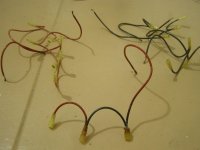dalmatiangirl61
Diamond
- Joined
- Jan 31, 2011
- Location
- BFE Nevada/San Marcos Tx
Yes, I'm not sure what to think at this point myself.
There are only 3 leads in the peckerhead, labeled 1, 2 and 3. There are 2 leads into the box on top, labeled 2 and 3. I think the wires out of top have continuity with corresponding numbered wires in the peckerhead, will verify tomorrow.
I attempted to send an as-is schematic to mfr today for verification, their inquiry system kept rejecting it, I will call again tomorrow and see if they can provide a direct email address.
Current thoughts, yank a few caps and see what happens, if acceptable, run with it for now, only 2 machines really need the 20hp capacity, see what happens when I get to them.
Option 2, yank all the caps, terminate those leads, treat is an an idler and build a control box where legs can individually be balanced.
There are only 3 leads in the peckerhead, labeled 1, 2 and 3. There are 2 leads into the box on top, labeled 2 and 3. I think the wires out of top have continuity with corresponding numbered wires in the peckerhead, will verify tomorrow.
I attempted to send an as-is schematic to mfr today for verification, their inquiry system kept rejecting it, I will call again tomorrow and see if they can provide a direct email address.
Current thoughts, yank a few caps and see what happens, if acceptable, run with it for now, only 2 machines really need the 20hp capacity, see what happens when I get to them.
Option 2, yank all the caps, terminate those leads, treat is an an idler and build a control box where legs can individually be balanced.






 .
.